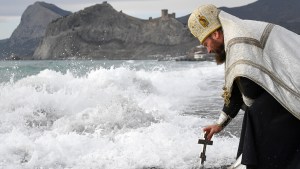In the Roman Rite of the Catholic Church, a few of the Sundays after Easter have special names or themes, such as Divine Mercy Sunday or Good Shepherd Sunday.
In the Catholic Byzantine and Eastern Orthodox Churches, there are names for every Sunday of the year.
This is because Byzantine Christians name Sundays after the events that are proclaimed in the Sunday Gospel.
Alexander George S. Papastephanos explains this in his book, The Divine Liturgy of St. John Chrysostom In Greek and English:
The various Sundays in the year are usually called after the Gospel of the day, rather than the Sunday after the principal feast just celebrated. Thus in the Greek rite the Sundays which follow Easter are respectively named, Sunday of Thomas, Sunday of Myrrh bearing Women, Sunday of the Paralytic, Sunday of the Samaritan Woman, Sunday the Blind Man.”
The third Sunday of the Easter season is called the, “Sunday of the Myrrh-Bearing Women.”
Sunday of the Myrrh-Bearing Women
The Byzantine Eparchy of Parma explains the theme of this Sunday on its website:
On the third Sunday after Pascha, we commemorate the brave women who were with Christ after His death and were the first ones to receive the joyous news about His resurrection.
The Sunday of the Myrrh-bearering Women icon portrays the women who went to anoint Christ’s body at the tomb. An angel sits on the stone covering the tomb and points to the empty garments, indicating Christ’s resurrection.
The Gospel passage of this event is recorded in the gospels of Matthew and Mark.
And when the sabbath was past, Mary Magdalene, and Mary the mother of James, and Salome, bought spices, so that they might go and anoint him. And very early on the first day of the week they went to the tomb when the sun had risen. And they were saying to one another, “Who will roll away the stone for us from the door of the tomb?” And looking up, they saw that the stone was rolled back; for it was very large. And entering the tomb, they saw a young man sitting on the right side, dressed in a white robe; and they were amazed.
Mark 16:1-5
One of the hymns used on this feast by Eastern Christians celebrates this event:
Unto the myrrh-bearing women did the Angel cry out as he stood by the grave: Myrrh-oils are meet for the dead, but Christ has proved to be a stranger to corruption. But cry out: The Lord is risen, granting great mercy to the world.
The Easter season is a special time of the year where we can linger on the various events connected to the resurrection of Jesus.



